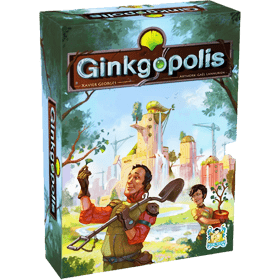Ginkgopolis
 2212. Ginkgo Biloba, the oldest and strongest tree in the world, has become the symbol of a new method for building cities in symbiosis with nature.
2212. Ginkgo Biloba, the oldest and strongest tree in the world, has become the symbol of a new method for building cities in symbiosis with nature.
In Ginkgopolis, you are urban planners, who build and operate the buildings of the city in order to gain as many success points as you can.
Number of players: 2 - 5
Game duration: 18 mn
Complexity: 3 / 5
Play Ginkgopolis and 1194 other games online.
No download necessary - play directly from your web browser.
With your friends and thousands of players from the whole world.
Free.

Play Ginkgopolis and 1194 other games online.
No download necessary - play directly from your web browser.
With your friends and thousands of players from the whole world.
Free.

Rules summary
Turns
All players simultaneously choose one action by either selecting a single card or a card and a tile. Once everyone has chosen, actions are resolved starting with the first player and continuing clockwise.
Actions
1 – Exploitation – discard a card from your hand.
Urbanization card = take either a resource or a tile from the general supply
Building card:
• red card: you get resources
• blue card: you get tiles
• yellow card: you get success points
The number of items you gain is determined by the height of the designated building. For each floor of the building, you get one item: a 1-floor building generates 1 item, a 2-floor building generates 2, etc. Earn items from your Exploit Tableau if applicable.
2 – Urbanization - When you play an Urbanization card with a tile, you expand the city by adding a new building on the outskirts.
• Select a tile in your supply and a Urbanization card (with a letter) in your hand.
• Place the tile at the corresponding Urbanization token (with a letter) on the board.
• Place 1 of your resources on the tile to mark you own this level 1 building.
• Move the Urbanization token you just replaced to an orthogonally adjacent empty space.
You utilize the buildings orthogonally adjacent to the one you just placed. “Utilizing a building” allows you to earn the items as if you had played those buildings’ cards by themselves as an Exploit action. Earn items from your Urbanizing Tableau if applicable.
3 – Construction - Playing a Building card with a tile When you play a Building card with a tile, you add a floor by placing the new tile on the building in the city indicated by the card.
• Return the resources present on the building designated by the card to their owner.
• If the owner of the building is another player, they receive 1 success point per resource returned to them.
• Place the tile you played atop the building designated by the card.
• If the number on the tile you are playing is less than the number on the tile you are covering, you must pay the difference in success points.
• If the color of the tile you’re playing is different than the one you are covering, pay 1 more resource.
• Place 1 resource per level of the new building on the tile.
• Earn items from your Construction Tableau if applicable.
Keep the played card face-up in your area. This card will give you its bonus for the rest of the game. There are 2 types of bonuses:
• permanent bonuses (with black arrow), which are activated throughout the game
• endgame bonuses (with the “=” icon), which will give you success points in the final scoring.
Game Over
The game ends after the supply of tiles is exhausted for the second time, or if a single player has placed all their resource markers (25, 20, 18, or 16 resources for 2, 3, 4, or 5 players respectively).
Note that after the supply of tiles is exhausted for the first time, the second supply is formed by all players contributing tiles form their supplies. They get one point for each tile contributed this way.
Your success points are then totaled:
• those earned during the game in the form of tokens
• those from cards with an endgame bonus (cards with the “=” icon )
• 2 success points for each unused New Hand token
• the success points according to players’ presence in the city districts
For the points earned in city districts (any group of two or more tiles adjacent of the same color is a district), each is scored separately.
• The player with the most of their resources in the district earns a number of points equal to the total resources in the district.
• The player in second place only scores for their own resources.
• In the case of a tie, the player with the tallest building in the district wins the tie.
• If it’s still a tie, the player with the tallest building showing the highest building number in the district wins the tie.
• If only one player has resources in the district, they get both sets of points, or 2x the number of their resources.

